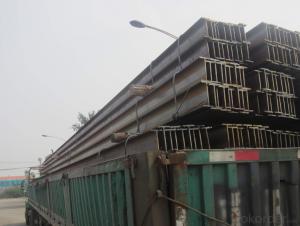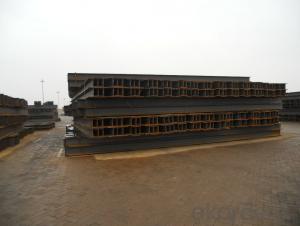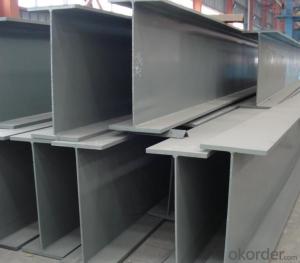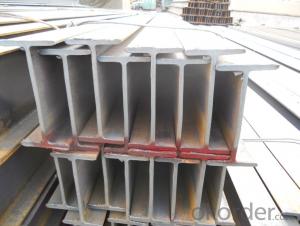High Quality Hot Rolled Jis Standard Steel H Beam
- Loading Port:
- Tianjin
- Payment Terms:
- TT OR LC
- Min Order Qty:
- 25 m.t.
- Supply Capability:
- 1000 m.t./month
OKorder Service Pledge
OKorder Financial Service
You Might Also Like
roduct Description:
Specifications of Hot Rolled Steel H-beam
1. Standard: GB
2. Grade: Q235 or Equivalent
3. Length: 6m,10m, 12m as following table
4. Invoicing on theoretical weight or actual weight as customer request
5.Payment: TT or L/C
6. Sizes:
Category | model (height*width)/ (mm×mm) | Section size/mm | Cross-section area/cm2 | Theoretical Weight/(kg/m) | Moment of inertia/cm4 | radius/cm | Section modulus/cm3 | |||||||
H | B | t1 | t2 | r | Ix | Iy | ix | iy | Wx | Wy | ||||
HW | 100×100 | 100 | 100 | 6 | 8 | 8 | 21.59 | 16.9 | 386 | 134 | 4.23 | 2.49 | 77.1 | 26.7 |
125×125 | 125 | 125 | 6.5 | 9 | 8 | 30.00 | 23.6 | 843 | 293 | 5.30 | 3.13 | 135 | 46.9 | |
150×150 | 150 | 150 | 7 | 10 | 8 | 39.65 | 31.1 | 1620 | 563 | 6.39 | 3.77 | 216 | 75.1 | |
175×175 | 175 | 175 | 7.5 | 11 | 13 | 51.43 | 40.4 | 2918 | 983 | 7.53 | 4.37 | 334 | 112 | |
200×200 | 200 | 200 | 8 | 12 | 13 | 63.53 | 49.9 | 4717 | 1601 | 8.62 | 5.02 | 472 | 160 | |
200 | 204 | 12 | 12 | 13 | 71.53 | 56.2 | 4984 | 1701 | 8.35 | 4.88 | 498 | 167 | ||
250×250 | 244 | 252 | 11 | 11 | 13 | 81.31 | 63.8 | 8573 | 2937 | 10.27 | 6.01 | 703 | 233 | |
250 | 250 | 9 | 14 | 13 | 91.43 | 71.8 | 10689 | 3648 | 10.81 | 6.32 | 855 | 292 | ||
250 | 255 | 14 | 14 | 13 | 103.93 | 81.6 | 11340 | 3875 | 10.45 | 6.11 | 907 | 304 | ||
HM | 150×100 | 148 | 100 | 6 | 9 | 8 | 26.35 | 20.7 | 995.3 | 150.3 | 6.15 | 2.39 | 134.5 | 30.1 |
200×150 | 194 | 150 | 6 | 9 | 8 | 38.11 | 29.9 | 2586 | 506.6 | 8.24 | 3.65 | 266.6 | 67.6 | |
250×175 | 244 | 175 | 7 | 11 | 13 | 55.49 | 43.6 | 5908 | 983.5 | 10.32 | 4.21 | 484.3 | 112.4 | |
HN | 100×50 | 100 | 50 | 5 | 7 | 8 | 11.85 | 9.3 | 191.0 | 14.7 | 4.02 | 1.11 | 38.2 | 5.9 |
125×60 | 125 | 60 | 6 | 8 | 8 | 16.69 | 13.1 | 407.7 | 29.1 | 4.94 | 1.32 | 65.2 | 9.7 | |
150×75 | 150 | 75 | 5 | 7 | 8 | 17.85 | 14.0 | 645.7 | 49.4 | 6.01 | 1.66 | 86.1 | 13.2 | |
175×90 | 175 | 90 | 5 | 8 | 8 | 22.90 | 18.0 | 1174 | 97.4 | 7.16 | 2.06 | 134.2 | 21.6 | |
200×100 | 198 | 99 | 4.5 | 7 | 8 | 22.69 | 17.8 | 1484 | 113.4 | 8.09 | 2.24 | 149.9 | 22.9 | |
200 | 100 | 5.5 | 8 | 8 | 26.67 | 20.9 | 1753 | 133.7 | 8.11 | 2.24 | 175.3 | 26.7 | ||
250×125 | 248 | 124 | 5 | 8 | 8 | 31.99 | 25.1 | 3346 | 254.5 | 10.23 | 2.82 | 269.8 | 41.1 | |
250 | 125 | 6 | 9 | 8 | 36.97 | 29.0 | 3868 | 293.5 | 10.23 | 2.82 | 309.4 | 47.0 | ||
300×150 | 298 | 149 | 5.5 | 8 | 13 | 40.80 | 32.0 | 5911 | 441.7 | 12.04 | 3.29 | 396.7 | 59.3 | |
300 | 150 | 6.5 | 9 | 13 | 46.78 | 36.7 | 6829 | 507.2 | 12.08 | 3.29 | 455.3 | 67.6 | ||
350×175 | 346 | 174 | 6 | 9 | 13 | 52.45 | 41.2 | 10456 | 791.1 | 14.12 | 3.88 | 604.4 | 90.9 | |
350 | 175 | 7 | 11 | 13 | 62.91 | 49.4 | 12980 | 983.8 | 14.36 | 3.95 | 741.7 | 112.4 | ||
400×150 | 400 | 150 | 8 | 13 | 13 | 70.37 | 55.2 | 17906 | 733.2 | 15.95 | 3.23 | 895.3 | 97.8 | |
HT | 100×50 | 95 | 48 | 3.2 | 4.5 | 8 | 7.62 | 6.0 | 109.7 | 8.4 | 3.79 | 1.05 | 23.1 | 3.5 |
97 | 49 | 4 | 5.5 | 8 | 9.38 | 7.4 | 141.8 | 10.9 | 3.89 | 1.08 | 29.2 | 4.4 | ||
100×100 | 96 | 99 | 4.5 | 6 | 8 | 16.21 | 12.7 | 272.7 | 97.1 | 4.10 | 2.45 | 56.8 | 19.6 | |
125×60 | 118 | 58 | 3.2 | 4.5 | 8 | 9.26 | 7.3 | 202.4 | 14.7 | 4.68 | 1.26 | 34.3 | 5.1 | |
120 | 59 | 4 | 5.5 | 8 | 11.40 | 8.9 | 259.7 | 18.9 | 4.77 | 1.29 | 43.3 | 6.4 | ||
125×125 | 119 | 123 | 4.5 | 6 | 8 | 20.12 | 15.8 | 523.6 | 186.2 | 5.10 | 3.04 | 88.0 | 30.3 | |
150×75 | 145 | 73 | 3.2 | 4.5 | 8 | 11.47 | 9.0 | 383.2 | 29.3 | 5.78 | 1.60 | 52.9 | 8.0 | |
147 | 74 | 4 | 5.5 | 8 | 14.13 | 11.1 | 488.0 | 37.3 | 5.88 | 1.62 | 66.4 | 10.1 | ||
150×100 | 139 | 97 | 4.5 | 4.5 | 8 | 13.44 | 10.5 | 447.3 | 68.5 | 5.77 | 2.26 | 64.4 | 14.1 | |
142 | 99 | 4.5 | 6 | 8 | 18.28 | 14.3 | 632.7 | 97.2 | 5.88 | 2.31 | 89.1 | 19.6 | ||
150×150 | 144 | 148 | 5 | 7 | 8 | 27.77 | 21.8 | 1070 | 378.4 | 6.21 | 3.69 | 148.6 | 51.1 | |
147 | 149 | 6 | 8.5 | 8 | 33.68 | 26.4 | 1338 | 468.9 | 6.30 | 3.73 | 182.1 | 62.9 | ||
175×90 | 168 | 88 | 3.2 | 4.5 | 8 | 13.56 | 10.6 | 619.6 | 51.2 | 6.76 | 1.94 | 73.8 | 11.6 | |
171 | 89 | 4 | 6 | 8 | 17.59 | 13.8 | 852.1 | 70.6 | 6.96 | 2.00 | 99.7 | 15.9 | ||
175×175 | 167 | 173 | 5 | 7 | 13 | 33.32 | 26.2 | 1731 | 604.5 | 7.21 | 4.26 | 207.2 | 69.9 | |
172 | 175 | 6.5 | 9.5 | 13 | 44.65 | 35.0 | 2466 | 849.2 | 7.43 | 4.36 | 286.8 | 97.1 | ||
200×100 | 193 | 98 | 3.2 | 4.5 | 8 | 15.26 | 12.0 | 921.0 | 70.7 | 7.77 | 2.15 | 95.4 | 14.4 | |
196 | 99 | 4 | 6 | 8 | 19.79 | 15.5 | 1260 | 97.2 | 7.98 | 2.22 | 128.6 | 19.6 | ||
200×150 | 188 | 149 | 4.5 | 6 | 8 | 26.35 | 20.7 | 1669 | 331.0 | 7.96 | 3.54 | 177.6 | 44.4 | |
Usage & Applications of Hot Rolled Steel H-beam
Commercial building structure ;Pre-engineered buildings; Machinery support structure; Prefabricated structure; Medium scale bridges; Ship-building structure. etc.
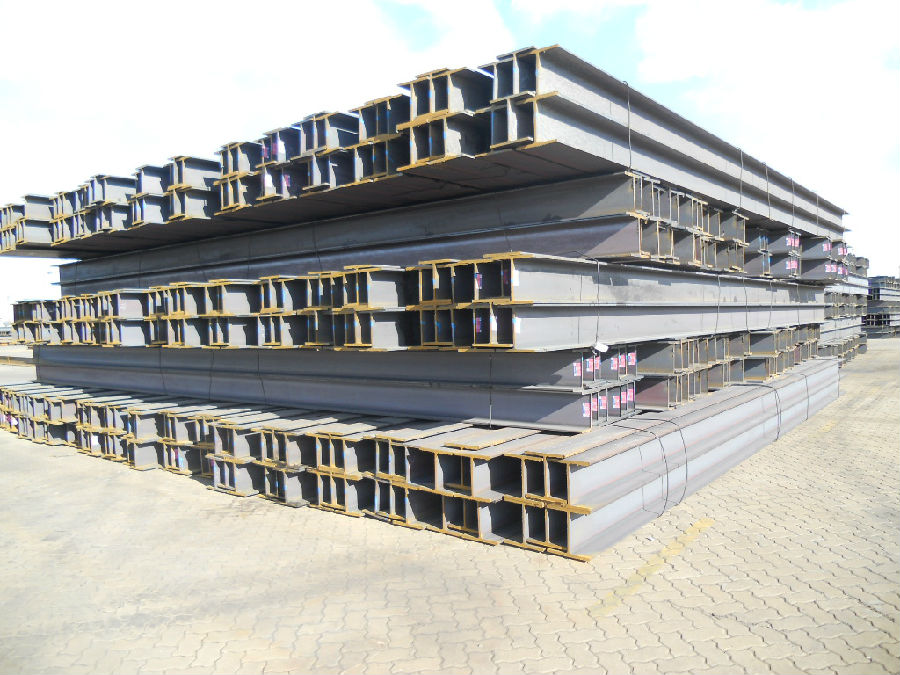

Packaging & Delivery of Hot Rolled Steel H-beam
1. Packing: it is nude packed in bundles by steel wire rod
2. Bundle weight: not more than 3.5MT for bulk vessel; less than 3 MT for container load
3. Marks:
Color marking: There will be color marking on both end of the bundle for the cargo delivered by bulk vessel. That makes it easily to distinguish at the destination port.
Tag mark: there will be tag mark tied up on the bundles. The information usually including supplier logo and name, product name, made in China, shipping marks and other information request by the customer.
If loading by container the marking is not needed, but we will prepare it as customer request.
4. Transportation: the goods are delivered by truck from mill to loading port, the maximum quantity can be loaded is around 40MTs by each truck. If the order quantity cannot reach the full truck loaded, the transportation cost per ton will be little higher than full load.
5. Delivered by container or bulk vessel
Production flow of Hot Rolled Steel H-beam
Material prepare (billet) —heat up—rough rolling—precision rolling—cooling—packing—storage and transportation
- Q:What's the difference between hot rolled H steel and welded H? Is it the same weight?
- Select various grades of steel. Hot rolled H steel is mainly Q235B and Q345B, which requires small batch of special steel, the production plant can not be produced. Welding can be made according to the requirements of the steel plate.
- Q:Can steel H-beams be used in the construction of sports arenas?
- Yes, steel H-beams can be used in the construction of sports arenas. Steel H-beams provide several advantages that make them suitable for this type of structure. Firstly, H-beams offer excellent strength and durability, allowing them to support the weight of large roof structures, seating areas, and other heavy loads commonly found in sports arenas. Additionally, steel H-beams have a high resistance to corrosion, which is crucial in structures exposed to various weather conditions. Moreover, the versatility of steel allows for the fabrication of H-beams in various sizes and shapes, ensuring they can be tailored to meet the specific design requirements of sports arenas. Overall, the use of steel H-beams in the construction of sports arenas ensures a safe and robust structure that can withstand the demands of hosting large crowds and supporting complex roof systems.
- Q:Can steel H-beams be used in sports stadiums and arenas?
- Yes, steel H-beams can be used in sports stadiums and arenas. They are commonly used in construction projects due to their strength and versatility. H-beams provide structural support and can withstand heavy loads, making them suitable for large-scale buildings like sports stadiums and arenas.
- Q:Can Steel H-Beams be used in retrofit or renovation projects?
- Yes, steel H-beams can certainly be used in retrofit or renovation projects. H-beams are commonly used in construction due to their strength, durability, and versatility. They are often employed to provide additional support or reinforcement to existing structures during renovation or retrofitting processes. H-beams can be used to replace or strengthen existing beams, columns, or other load-bearing elements in a building, ensuring the structural integrity of the renovated or retrofitted structure. Additionally, H-beams can be used to create new structural elements such as mezzanines, balconies, or platforms in retrofit or renovation projects. Their ability to bear heavy loads and distribute weight evenly makes them an ideal choice for such applications. Overall, steel H-beams are widely used in retrofit or renovation projects to enhance the strength and stability of existing structures.
- Q:What are the advantages of using steel H-beams over other types of beams?
- Steel H-beams offer numerous benefits compared to other types of beams. To begin with, their high strength-to-weight ratio allows them to bear heavy loads while remaining relatively lightweight. This makes them ideal for applications that require robust and enduring structural support, such as constructing buildings, bridges, and industrial structures. Moreover, steel H-beams possess a consistent shape and size, making them easy to install and work with. Manufactured to strict standards, they ensure uniformity and precision in their dimensions. This uniformity facilitates quick and efficient assembly, thereby saving time and reducing labor costs during construction. Additionally, steel H-beams exhibit exceptional load-bearing capacity. Their H shape enables the even distribution of weight along the beam's length, enabling them to support substantial loads without bending or buckling. Hence, they prove suitable for long-span applications, where extensive distances need to be covered without requiring additional support columns. Furthermore, steel H-beams demonstrate remarkable versatility, finding uses across a wide range of applications. They can be easily customized and fabricated to meet specific project requirements, whether it be in residential, commercial, or industrial construction. Moreover, steel H-beams can be effortlessly connected and joined using various methods, allowing for flexibility in design and construction. Lastly, steel H-beams boast durability and resistance to corrosion, making them suitable for both indoor and outdoor applications. They possess a long lifespan and necessitate minimal maintenance, reducing overall lifecycle costs. This durability ensures the long-term structural integrity of buildings and structures, providing stability and safety over time. In conclusion, the advantages of utilizing steel H-beams surpass those of other beam types. Their high strength-to-weight ratio, consistent shape and size, excellent load-bearing capacity, versatility, durability, and corrosion resistance make them the preferred choice in various construction projects. By employing steel H-beams, the structural stability and longevity of the built environment are ensured.
- Q:Are steel H-beams resistant to rot or decay?
- No, steel H-beams are not resistant to rot or decay. Unlike wood, steel does not rot or decay, as it is not an organic material. Steel beams are made from iron with varying amounts of carbon and other elements, which gives them their strength and durability. However, it is important to note that while steel beams are not prone to rot or decay, they can still corrode over time due to exposure to moisture and other environmental factors. To prevent corrosion, steel beams are often coated with protective layers, such as paint or galvanization, which helps to extend their lifespan and maintain their structural integrity.
- Q:Can steel H-beams be used in the construction of residential complexes or apartments?
- Steel H-beams are indeed applicable for the construction of residential complexes or apartments. These structural components are known for their strength and versatility, making them a common choice in construction projects. Compared to materials like wood or concrete, steel H-beams offer several advantages. To begin with, steel H-beams possess a high strength-to-weight ratio, enabling them to bear heavy loads while remaining relatively lightweight. This characteristic makes them ideal for the construction of large or multi-story buildings such as residential complexes or apartments. Furthermore, steel H-beams exhibit exceptional durability and resistance to various environmental factors, including earthquakes, hurricanes, and termites. Their high tensile strength allows them to endure significant forces and deformations without breaking. Moreover, steel H-beams can be easily customized to meet specific design requirements. They can be effortlessly cut, welded, and bolted together, facilitating flexible construction designs. A notable aspect of steel is its sustainability and eco-friendliness. It can be recycled indefinitely without compromising its innate properties, making it an environmentally responsible choice for construction projects. In conclusion, steel H-beams offer a multitude of advantages that render them suitable for the construction of residential complexes and apartments. Their strength, durability, versatility, and sustainability make them a favored option among architects and builders in the construction industry.
- Q:How do steel H-beams perform in wind-prone areas?
- Steel H-beams are highly durable and strong structural elements that are commonly used in construction, especially in wind-prone areas. These beams are designed to withstand various forces, including wind loads, making them an excellent choice for buildings and structures in regions prone to strong winds. The shape and design of H-beams allow for superior load-bearing capacity and resistance to bending and twisting. This makes them highly effective in withstanding the forces imposed by high winds. The H shape of the beam provides a large surface area, which helps distribute the wind load evenly across the structure, reducing the risk of failure. Additionally, steel is known for its high strength-to-weight ratio, making H-beams a lightweight yet robust choice for wind-prone areas. This ensures that the structure can withstand the dynamic and fluctuating forces exerted by strong winds without compromising its overall integrity. Furthermore, steel H-beams have excellent resistance to corrosion, which is crucial in areas with high humidity or exposure to saltwater, as these conditions can accelerate the deterioration of other building materials. The corrosion resistance of steel H-beams ensures their longevity and structural integrity in wind-prone regions, minimizing the need for frequent maintenance or replacement. In summary, steel H-beams perform exceptionally well in wind-prone areas due to their high strength, load-bearing capacity, resistance to bending and twisting, and corrosion resistance. Their ability to withstand wind loads and their durability make them a reliable choice for constructing buildings and structures in regions with strong winds.
- Q:What are the different types of steel H-beam connections used in industrial facilities?
- There are several different types of steel H-beam connections commonly used in industrial facilities. These connections are crucial for providing structural stability and support in large-scale construction projects. Here are some of the most frequently used types of steel H-beam connections in industrial facilities: 1. Welded connections: This is the most common type of connection used in industrial facilities. It involves welding the H-beams together at the joint, creating a strong and rigid connection. Welded connections are known for their high strength and durability, making them suitable for heavy-duty applications. 2. Bolted connections: In this type of connection, the H-beams are secured together using bolts and nuts. Bolted connections offer the advantage of being easily disassembled and reassembled, making them ideal for situations where flexibility and future modifications are required. However, they may not be as strong as welded connections. 3. Riveted connections: Riveting is an older method of connecting H-beams that involves using metal rivets to join the beams together. Riveted connections have been largely replaced by welded and bolted connections due to their higher cost and time-consuming installation process. However, they are still used in some historical or heritage structures. 4. Moment connections: Also known as rigid connections, moment connections are designed to resist bending moments and provide greater stability. These connections involve welding or bolting additional plates to the beam ends, creating a stiffer connection that can resist rotational forces. 5. Pinned connections: Pinned connections allow for rotation between the beams, providing flexibility in the structure. These connections are commonly used in structures where movement or deflection is expected, such as bridges or earthquake-resistant buildings. Pinned connections can be achieved through the use of specialized pins or bearings. 6. Shear connections: Shear connections are used to transfer shear forces between the beams. These connections are typically made through the use of bolts or welding additional plates to the beam ends. Shear connections are crucial for ensuring the structural integrity of the H-beam system during lateral loads or vibrations. It is important to note that the selection of the appropriate H-beam connection type depends on various factors such as the load-bearing requirements, structural design, project specifications, and cost considerations. Consulting with a structural engineer or construction professional is recommended to determine the most suitable connection type for a specific industrial facility.
- Q:What are the requirements for steel H-beams in hurricane-prone regions?
- In hurricane-prone regions, steel H-beams must meet certain requirements to ensure the structural integrity and safety of buildings and structures. These requirements are designed to withstand the high wind speeds and potential impact from flying debris that hurricanes can bring. One of the primary requirements for steel H-beams in hurricane-prone regions is the need for high strength and durability. The beams must be able to resist the strong forces exerted by hurricane winds, which can reach speeds of over 150 miles per hour. This typically means using high-grade steel with a high yield strength and tensile strength, ensuring the beams can withstand the wind pressure and prevent structural failure. Another important consideration is the design and shape of the H-beams. The shape of the beam, with its flanges and web, helps distribute the load and provide stability. In hurricane-prone regions, H-beams with wider flanges and thicker webs are often preferred as they offer better resistance to bending and torsion forces caused by high winds. The design of the beam should also consider factors such as the appropriate depth and width to provide optimal strength and stability. In addition to the material and design, the installation and connection of steel H-beams in hurricane-prone regions must also meet specific requirements. The connections between beams and other structural elements need to be robust and able to resist the dynamic forces generated by hurricane winds. Welding or bolting techniques must be used to ensure a strong and secure connection that can withstand the lateral and uplift forces associated with hurricanes. Lastly, compliance with building codes and regulations is crucial in hurricane-prone regions. Local building codes often provide specific guidelines for the use of steel H-beams in these areas, including factors such as minimum design loads, wind speed requirements, and installation techniques. It is important to consult with local authorities and engineers familiar with hurricane-resistant design to ensure compliance with all relevant codes and regulations. Overall, the requirements for steel H-beams in hurricane-prone regions revolve around strength, durability, appropriate design, secure connections, and compliance with building codes. By meeting these requirements, steel H-beams can contribute to the construction of resilient buildings and structures that can better withstand the destructive forces of hurricanes.
1. Manufacturer Overview |
|
|---|---|
| Location | |
| Year Established | |
| Annual Output Value | |
| Main Markets | |
| Company Certifications | |
2. Manufacturer Certificates |
|
|---|---|
| a) Certification Name | |
| Range | |
| Reference | |
| Validity Period | |
3. Manufacturer Capability |
|
|---|---|
| a)Trade Capacity | |
| Nearest Port | |
| Export Percentage | |
| No.of Employees in Trade Department | |
| Language Spoken: | |
| b)Factory Information | |
| Factory Size: | |
| No. of Production Lines | |
| Contract Manufacturing | |
| Product Price Range | |
Send your message to us
High Quality Hot Rolled Jis Standard Steel H Beam
- Loading Port:
- Tianjin
- Payment Terms:
- TT OR LC
- Min Order Qty:
- 25 m.t.
- Supply Capability:
- 1000 m.t./month
OKorder Service Pledge
OKorder Financial Service
Similar products
New products
Hot products
Related keywords
